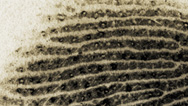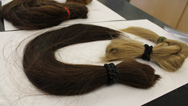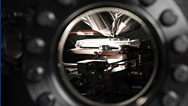Death Detectives
- Posted 10.17.12
- NOVA scienceNOW
Determining a victim's time of death isn't as easy as it sounds. With a visit to the state morgue and a "body farm," we explore the biological forces behind a corpse's decomposition, learn how rigor mortis works, and witness how scavenging vultures can throw investigators dangerously off-track.
Transcript
Can Science Stop Crime?
PBS Airdate: October 17, 2012
My next stop takes me on one of my most disturbing missions, ever. I'm at a special research site at Texas State University, where scientists study what happens to human bodies after they die.
Tell me again why you put dead human bodies in this field?
MICHELLE HAMILTON: Well, we're really interested in asking questions about time-since-death, decomposition. And the best way to do that is to actually simulate a crime scene or a death scene, so that's what we're doing.
We need to be careful where we step. There are rattlesnakes out here.
DAVID POGUE: Oh, great. Now we've got rattlesnakes.
MICHELLE HAMILTON: This is Texas.
So, there are different kinds of research strategies.
DAVID POGUE: Forensic anthropologist Michelle Hamilton and her team have laid out the remains of people who donated their bodies to help solve some big mysteries: How do different environments affect and alter decomposition? And when confronted with a corpse, how accurately can we determine when someone died?
Here's something.
Oh, my gosh. Please don't tell me that's hair.
MICHELLE HAMILTON: That's hair.
DAVID POGUE: Wow. Is this a he or a she?
MICHELLE HAMILTON: This is a she.
DAVID POGUE: And you know that because you guys put her out here?
MICHELLE HAMILTON: Right.
DAVID POGUE: She donated her body, and you placed her here?
MICHELLE HAMILTON: Exactly.
So how long do you think the skeleton has been out here?
DAVID POGUE: Oh, nine months, a year?
MICHELLE HAMILTON: You know, I think six months to a year is a good guess when you see a skeleton in this state, but it's wrong. This individual, three days ago, was fully fleshed.
DAVID POGUE: Three days? But how could that be? This thing is bleached, dry bones and scattered all around. There's nothing left.
MICHELLE HAMILTON: Well, that's what we're going to try to find out.
DAVID POGUE: In a real crime, my mistake could be critical.
MICHELLE HAMILTON: Knowing how long it is that a body has been out and decomposing, will help us for things like putting a perpetrator at a scene, so timing is really crucial.
KATE SPRADLEY (Texas State University): They may have an alibi for a specific time, and if our time-of-death estimate is wrong, then that person may never get caught.
Film Clip: I tentatively place the time of death at two to four months ago.
DAVID POGUE: But with the stakes so high, how do experts actually estimate time-since-death?
Film Clip: She died within the last 12 hours.
DAVID POGUE: On TV, they always make it look so easy!
Film Clip: I estimate time of death at or around four days.
DAVID POGUE: To find out how it really works, I'm visiting the Massachusetts Office…
Oh, wow.
…of the Chief Medical Examiner, the state morgue.
What goes on in here?
PETER CUMMINGS: This is the autopsy suite, and this is where we do all our postmortem examinations.
DAVID POGUE: Forensic pathologist Peter Cummings performs about 300 autopsies a year, including cases with suspicious circumstances.
PETER CUMMINGS: This is a typical autopsy station.
DAVID POGUE: In addition to finding the cause of death, it's his job to determine when a person died.
Now, I'm not a forensic pathologist, but I've seen one on TV. And I know that they always go, "Your Honor, the time of death was 10:43."
So, how do they know so precisely when somebody died?
PETER CUMMINGS: Good writers?
DAVID POGUE: You mean that's not based on reality?
PETER CUMMINGS: Uh, no. I wish, I wish we could do that. The majority of my death certificates, unfortunately, I have to put "unknown" for time of death, because I don't know.
DAVID POGUE: What do you mean you don't know?
PETER CUMMINGS: I don't know.
DAVID POGUE: You always know. They always put, "Time of death, 7:22."
PETER CUMMINGS: I wish. We can estimate, but we can't really get an exact time of death.
DAVID POGUE: All right, so how do you even estimate?
PETER CUMMINGS: Come here. I'll show you.
DAVID POGUE: You want me to get up on this thing?
PETER CUMMINGS: Yes, sir. Hop up.
DAVID POGUE: Isn't this usually reserved for less animated people?
PETER CUMMINGS: Typically.
The first thing we'll talk about is rigor mortis.
Put your arms up like this, David.
DAVID POGUE: This is how I died?
PETER CUMMINGS: This is how you died.
DAVID POGUE: I died while I was, you know, using a dousing rod or something?
PETER CUMMINGS: Let's think reading in bed.
DAVID POGUE: Okay, reading in bed.
PETER CUMMINGS: Don't let me move you. Try to resist me, okay?
DAVID POGUE: Okay.
PETER CUMMINGS: So, with rigor, what will happen is your muscles will freeze like this, and I won't be able to move you.
What happens is, with the body, your muscle contractions are dependent upon energy production.
DAVID POGUE: When we're alive, our muscles move through the interaction of two different proteins.
Tiny extensions from one grab and pull on the other, over and over again, to produce movement. But before the proteins can let go of each other, they need an energy boost from a little molecule called A.T.P.
PETER CUMMINGS: So, what'll happen, when you die, you stop producing A.T.P., so your muscles can't relax, and they'll stay in the position that you died in, if you're left there for a long enough period of time.
DAVID POGUE: It takes about three hours after death for the A.T.P. in our muscle cells to get completely used up, and then our muscles begin to lock into place.
PETER CUMMINGS: So if you've just died—put your arms down, and let me—and I'm able to do this to you? If I touch you, and you feel warm, you've probably been dead less than three hours.
And if your body's cold and then flaccid again, and I can move you around really easily, I know you've been dead more than 36 hours.
DAVID POGUE: Wait a minute, rigor mortis goes away?
PETER CUMMINGS: It comes and goes.
DAVID POGUE: Really?! I thought you just got stiff and then that's how you are.
PETER CUMMINGS: No, what happens is your muscles will start to decompose. Just like leaving a piece of steak on a counter, it's going to get brown and mushy; the same thing happens to your muscles. So the actual physical fibers break down, and then your rigor mortis goes away.
DAVID POGUE: And as soon as decomposition really gets going, detecting time of death gets a lot trickier.
The biggest factor in decomposition is the temperature around the body, especially outdoors.
PETER CUMMINGS: Unfortunately, people don't always die in their home, at a nice room temperature. There are people that die outside on hiking trails, or people that die in water. So the environment and where you die and where your body's disposed of can greatly effect how you decompose.
DAVID POGUE: That's where that Texas field with the body comes into play. TV crime shows call it a "body farm."
PETER CUMMINGS: These are fascinating places. They take humans and do all kinds of things to them, to see how they decompose in the environment, what factors affect it, because there are so many things about a decomposed body that can trick you.
DAVID POGUE: Here, at Texas State University, experts like Forensic Anthropologist Kate Spradley investigate the rate, pattern and timelines of human decay.
KATE SPRADLEY: Especially watch your step over here.
DAVID POGUE: They've made some surprising discoveries. For one, bodies in Texas decompose faster in the shade than in the sun.
KATE SPRADLEY: Most of the bodies that we lay out, at our facility, here, in the sun, never fully decompose, they mummify.
DAVID POGUE: You're kidding.
KATE SPRADLEY: And they can do that in about three to four months.
DAVID POGUE: But in the shade, where there's less light, tissue is consumed more quickly, like on this pig carcass.
The culprits come from flies, which land on the body almost immediately and start laying eggs.
JEFF TOMBERLIN (Texas A&M University): So if we come over here and look under the limbs, we might find something here. And, lo and behold, this is all eggs.
DAVID POGUE: Oh, my gosh.
JEFF TOMBERLIN: Literally in the thousands of eggs.
So, in fact, we could probably pull off some eggs here and give you something to look at. So this is all eggs.
You can see they're hatching right now.
DAVID POGUE: Oh, it's moving!
When the eggs hatch, they become maggots.
It's moving!
And by studying the time it takes to develop from egg to maggot to fly, in different environments, investigators can start to estimate time since death.
But how do you estimate time of death, when there's hardly any body at all?
Remember that skeleton I found the other night? I'm told it was a flesh-filled body, just three days ago.
In the light of day, Kate Spradley shows me another skeleton in similar condition.
KATE SPRADLEY: So what you see right here, the mandible, the lower jaw of the individual we used in our study…
DAVID POGUE: Wow.
KATE SPRADLEY: This was where we placed our body donation.
DAVID POGUE: This is where the body was? Where there is nothing now but the lower jaw?
KATE SPRADLEY: Where there is nothing now but the lower jaw.
And then, if you look over here, you can see the bleached white bones, and those are the disarticulated and dispersed skeleton elements.
DAVID POGUE: Incredibly, the bones are now 20 feet from where the body was placed.
What could scatter bones and consume a body so quickly? Spradley had to find out.
KATE SPRADLEY: It was not characteristic of anything that we'd ever seen before.
DAVID POGUE: So she set up a motion-sensing camera and put a pig carcass out to discover what happened. And this is what the camera recorded: vultures.
The fact that vultures can reduce an entire carcass to skin and bones is no surprise, but their speed and efficiency were a revelation to the Texas team.
So it took science to tell us that vultures come and eat dead bodies? Isn't that well known?
KATE SPRADLEY: It is well known. However, it's not well known how fast they render a human skeleton down to bones.
DAVID POGUE: How long does it take?
KATE SPRADLEY: It takes about five hours.
DAVID POGUE: Five hours? They're like the piranhas of the sky.
KATE SPRADLEY: Absolutely. It really turns everything that we know on its head.
Our study found that vultures can significantly impact a crime scene, by throwing off estimations of time since death. They can render a body to a complete skeleton in five hours. Normally, it could take weeks, if not months. That really throws off the estimate of time since death.
DAVID POGUE: Spradley and her team are carefully documenting the vulture evidence, plotting the patterns of how bones scatter in Texas.
They hope the database they create will help investigators in real cases recognize the signs of a scavenger attack and avoid drastic mistakes, like estimating that a body has been outside for months, when it's only been a few days.
Do you get angry birds on this thing?
ALBERTO GIORDANO: No, you get vultures.
DAVID POGUE: Thanks to outdoor labs like this one, investigators are getting better and better at interpreting the evidence of real crime scenes.
PETER CUMMINGS: It's very important stuff. And they're starting to collect this data that's going to be very important to me, down the road, to be able to get that pinpoint number of, "This person died at 10:22." And that's the point of the science.
What does death smell like?
Two of the smelliest chemicals
produced by decaying bodies are…
Cadaverine
and Putrescine
Even if you've never been near a corpse,
you've probably smelled them…
in bad breath!
Credits
CAN SCIENCE STOP CRIME?
- HOST
- David Pogue
- WRITTEN, PRODUCED AND DIRECTED BY
- Scott Tiffany
Tadayoshi Kohno Profile
- WRITTEN AND DIRECTED BY
- Joshua Seftel
- PRODUCED BY
- Joshua Seftel & Erika Frankel
NOVA scienceNOW
- EXECUTIVE PRODUCER
- Julia Cort
- PRODUCTION MANAGER
- Stephanie Mills
- BUSINESS MANAGER
- Elizabeth Benjes
- INTERSTITIALS PRODUCED BY
- Brian Edgerton
- ORIGINAL MUSIC BY
- Christopher Rife
- SENIOR RESEARCHER
- Kate Becker
- CAN SCIENCE STOP CRIME? EDITED BY
- Brian Cassin
Steve Audette - PROFILE EDITED BY
- Marc Vives
- PRODUCTION MANAGER
- Maureen Lynch
- PROFILE PRODUCTION SUPERVISOR
- Jill Landaker Grunes
- ASSOCIATE PRODUCERS
- Mary Beth Griggs
Ben Sweeney
Catherine Bright - ARCHIVAL RESEARCH
- Minna Kane
Adam Talaid - RESEARCH
- Christopher O'Brien
Rachel Nuwer - CAMERA
- Jason Longo
Jeremiah Crowell
Ben McCoy
Mark Carroll
Paul Mailman - SOUND RECORDISTS
- Alex Altman
Mike Bellaccio
Steve Bonarrigo
Adriano Bravo
Steve Clack
Jason Pawlak - Scott Snyder
- Charles Tomaras
- ANIMATION BY
- Hero4Hire Creative, LLC
- ADDITIONAL MUSIC
- Scorekeeper's Music
- COLORIST
- Michael H. Amundson
- AUDIO MIX
- Heart Punch Studio, Inc.
- ADDITIONAL EDITING
- Rob Tinworth
Jean Dunoyer - ADDITIONAL CAMERA
- Zach Kuperstein
Jess Bichler
Ian Blair
A.J. Marson
Victoria Resendez
Oren Soffer
Alfonso Solis - MEDIA MANAGER
- Andrew Clark
- ASSISTANT EDITORS
- Rob Chapman
Steve Benjamin
Ben Sweeney - PRODUCTION ASSISTANTS
- Lee Stevens
Siena Brown
Nicole Beaudopin
Rebecca Brinson
Lauren Love
Matt Mohebalian
Gavin Murray
Stephanie Santos - POST PRODUCTION ASSISTANT
- Olaf Steel
- ARCHIVAL MATERIAL
- Pond5
Marcus R. Donner
Framepool
Shutterstock Images LLC
Dr. Arthur W. Toga, Laboratory of Neuro Imaging at UCLA
Library of Congress, Prints & Photographs Division
Denver Public Library, Western History Collection, Harry Rhoads
-------
Mice footage courtesy "A Tale of Two MAO Genes" (2010),
produced by Prof. Jean Chen Shih and Prof. Marsha Kinder,
University of Southern California
Library of Congress, Prints & Photographs Division
Data Visualization by Arction Ltd.
- SPECIAL THANKS
- Academy for Scientific Investigative Training
Tim Acosta
Brookhaven National Laboratory
-------
Cold Springs Harbor Laboratory
ECS Elite Combat Sports
Evergreen Speedway/High Road Promotions
Joshua Buckholtz
Adele Testani
HurryDate
Forensic Anthropology Center at Texas State
Clark Freshman
Rex Jung, Ph.D, Department of Neurosurgery, University of New Mexico
Minakami Karate
-------
Hank Levy
David Matsumoto
Derek Mitchell
Jeff Moss
Stephen Porter
Rocktagon MMA
Rogue Empire Gym
Saloon NYC
University of Washington
Vanderbilt University Law School
Michael Warren - ADVISORS
- Sangeeta Bhatia
Charles Jennings
Richard Lifton
Neil Shubin
Rudy Tanzi - NOVA SERIES GRAPHICS
- yU + co.
- NOVA THEME MUSIC
- Walter Werzowa
John Luker
Musikvergnuegen, Inc. - ADDITIONAL NOVA THEME MUSIC
- Ray Loring
Rob Morsberger - POST PRODUCTION ONLINE EDITOR
- Spencer Gentry
- CLOSED CAPTIONING
- The Caption Center
- MARKETING AND PUBLICITY
- Karen Laverty
- PUBLICITY
- Eileen Campion
Victoria Louie - NOVA ADMINISTRATOR
- Kristen Sommerhalter
- PRODUCTION COORDINATOR
- Linda Callahan
- PARALEGAL
- Sarah Erlandson
- TALENT RELATIONS
- Scott Kardel, Esq.
Janice Flood - LEGAL COUNSEL
- Susan Rosen
- DIRECTOR OF EDUCATION
- Rachel Connolly
- DIGITAL PROJECTS MANAGER
- Kristine Allington
- DIRECTOR OF NEW MEDIA
- Lauren Aguirre
- ASSOCIATE PRODUCER
POST PRODUCTION - Patrick Carey
- POST PRODUCTION EDITOR
- Rebecca Nieto
- POST PRODUCTION MANAGER
- Nathan Gunner
- COMPLIANCE MANAGER
- Linzy Emery
- DEVELOPMENT PRODUCERS
- Pamela Rosenstein
David Condon - COORDINATING PRODUCER
- Laurie Cahalane
- SENIOR SCIENCE EDITOR
- Evan Hadingham
- SENIOR PRODUCER
- Chris Schmidt
- SENIOR SERIES PRODUCER
- Melanie Wallace
- MANAGING DIRECTOR
- Alan Ritsko
- SENIOR EXECUTIVE PRODUCER
- Paula S. Apsell
A Time Frame Films Production for NOVA
NOVA scienceNOW is a trademark of the WGBH Educational Foundation
NOVA scienceNOW is produced for WGBH/Boston
This material is based upon work supported by the National Science Foundation under Grant No. 0917517. Any opinions, findings, and conclusions or recommendations expressed in this material are those of the author(s) and do not necessarily reflect the views of the National Science Foundation.
© 2012 WGBH Educational Foundation
All rights reserved
Image credit:
- (skull on grass)
- © WGBH Educational Foundation
Participants
- Peter Cummings
- Medical Examiner
- Michelle D. Hamilton
- Texas State University
- Kate Spradley
- Texas State University
Related Links
-

Can Science Stop Crime?
Explore the genetics behind criminal minds, the latest in lie detection, a human corpse "farm," and more.
-

Forensics on Trial
Virtual autopsies, 3-D fingerprints, and digital crime scenes are making crime-solving into a more precise science.
-

Strands of Evidence
Your hair may reveal more about you than you realize—including where you live and where you have been.
-

Stable Isotopes in Forensics
Investigators use elemental variations to unearth new leads.



